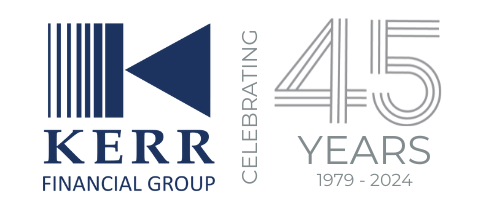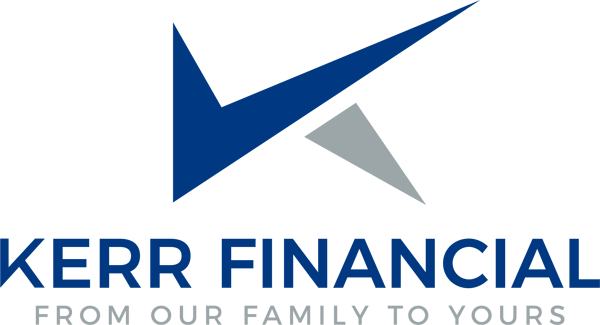
Kerr Financial turned 45 years old! Over the years we have worked with many successful Canadian families, helping them maximize their personal finances. To celebrate this momentous milestone we would like to share 45 Investment Tips to help you maximize your personal wealth.
Download the 45 Investment Tips PDF Here
45 Investment Tips!
- Set investment goals. Before investing any money, ensure that you know what you want to achieve with your investment portfolio as that will help determine how the portfolio should be invested.
- Understand your tolerance for volatility and risk. Make sure that you understand your comfort level with volatility as that too will help determine how the portfolio should be invested. If you can’t stomach any volatility in the portfolio’s returns, then you may need to have a portfolio of lower risk investments.
- Long-term growth doesn’t come without volatility. Understand that to achieve long-term growth in a portfolio, you must be willing to endure some volatility. Nothing grows in a straight line and equities, which are more volatile than bonds, have historically delivered superior returns over the long term
- Understand the basics of investing. Even if you aren’t interested in investing, make sure you understand the difference between cash, stocks and bonds and their roles in an investment portfolio. The more informed you are, the better you will understand your portfolio and how it will behave during different markets
- If you don’t have the time to manage your investments by yourself, hire a professional. Investing requires a lot of time and knowledge to do it well. If you don’t have the time, hire a professional as they have the knowledge and expertise to ensure that your investment portfolio will help you achieve your goals.
- If you hire a professional, make sure it is a good fit. Make sure that you understand the type of service they provide and that it suits your needs and personality. Ask lots of questions and make sure you are comfortable with your choice.
- Don’t look strictly at fees but rather assess the value provided for those fees. Investment management services cost money but if they deliver better results than what you can do on your own, then the fees are worth it. Ensure that you understand the services provided and that they meet your needs.
- Have an investment plan and stick to it. Having a plan will help you avoid emotional decision-making as it should keep you focused on achieving your goals rather than focusing on and reacting to the ups and downs of the market. Long-term goals can’t be achieved if you react to short-term fluctuations.
- Diversify your investments. Diversification across asset classes and geographies allows you to achieve a smoother return profile as typically, when one asset class or market is doing poorly, another is doing well. Given that Canada is only 3% of the global equity market, investing outside Canada also allows you to benefit from the trends in the rest of the world.
- Don’t chase a hot tip. Hot tips are akin to gambling and if you don’t understand what you’re buying and the risks involved, you could lose a lot of money.
- Conduct your own due diligence. When choosing stocks or bonds, make sure to do your own research and understand the characteristics of the investments, the potential upside and most importantly, the potential downside. Unless you are paying someone for their expertise, don’t rely on others as they aren’t necessarily focused on your best interests.
- Buy what you know and understand. If you don’t understand what you’re buying, then you won’t understand the risks involved and may end up with a nasty surprise if the investment goes south. When you know and understand what you’re buying, you won’t be surprised by price movements, whether they be up or down.
- Avoid leverage. Unless you can withstand the potential losses associated with borrowing to invest, avoid doing it. The potential upside isn’t worth the potential downside.
- Don’t try to hit home runs – focus on singles and doubles. No one can consistently choose big winners in the stock market and the strategy of trying to hit home runs usually results in poor long-term returns.
- Stop comparing your returns with your friends’ returns – you are comparing apples to oranges. Focus on whether you are on track to achieve your goals and remain comfortable with the level of risk inherent in the portfolio. Your friends will have different goals and different risk tolerance.
- Learn from your mistakes. Mistakes will allow you to become a better investor if you learn from them and don’t repeat them. Everyone makes mistakes – even the professionals.
- Make investing automatic – set up automatic contributions to investment accounts. Having automatic contributions or forced savings will help ensure you can achieve your goals. It also reduces the number of decisions you need to make with respect to your investment portfolio and eliminates the desire to try to time the market.
- Invest early – the magic of compounding. The earlier you can begin investing, the faster you will achieve your goals and the less you will have to contribute to your investment portfolio to achieve those goals.
- Don’t try to time the market. No one can predict the collective behaviour of millions of investors. As one legendary investor once said – the market can remain irrational longer than you can remain solvent.
- Be mindful of taxes – ensure that portfolio construction considers the taxation characteristics of different investment accounts and asset types. This is one of the simplest ways to boost your after-tax returns that is completely within your control.
- Understand your investment horizon. If your time horizon is long term, the portfolio can withstand more volatility and should be invested in asset classes that are more volatile. If your time horizon is short, you should be invested in low volatility assets as you will not have the time to make up any losses.
- Review periodically, not daily. Check your portfolio from time to time to ensure you are on track to achieve your goals but avoid checking daily as there is too much noise and it could cause you to make emotional decisions rather than rational ones.
- Have an emergency fund. This will allow you more peace of mind as you will know that you have a cushion if something unexpected happens.
- Spend less than you earn, invest the rest. This is the surest way to financial freedom and peace of mind.It is simple and completely within your control.
- Watch out for high and/or hidden fees. High and/or hidden fees eat away at your returns and ensure that you will have to work harder than necessary to achieve your goals. Make sure you understand all the fees and that you are getting value for those fees.
- Invest in companies and not stocks. When choosing stocks, remember that you are buying a part of a business and not gambling at the casino. Make sure you are comfortable with the business you are buying and are comfortable with the price you are paying.
- Don’t get caught up in the day-to-day ups and downs. Invest in strong companies with reputable management and stay the course.
- A diversified portfolio and long-term outlook leads to compounded gains over time.
- Prepare to live a long life. The average life expectancy in Canada continues to rise and many Canadians are living well into their 90s. Ensure your investment plans properly reflect an adequate time horizon and do not comprise future spending needs.
- Be cautious of annuities and other life insurance products that are associated with an income guarantee. The costs of the guarantee can be substantial and are being paid with elevated fees.
- Consider ways to consolidate your assets. This can reduce administrative costs, help simplify your portfolio holdings to avoid duplication and facilitate tax efficiency strategies.
- Find ways you can provide your family with financial support. One way is to start helping fund the cost of your grandchildren’s education by investing in a registered education savings plan (RESP).
- We are all human and vulnerable to behavioural biases that threaten to wreak havoc on our portfolio. Overconfidence, herding and risk-aversion bias are some of the cognitive and emotional biases investors need to be constantly aware of and protect against.
- Educate yourself. It has never been easier to learn about investing with high quality and easily accessible educational material available on the internet via websites, blog posts and podcasts.
- Make sure you have designated beneficiaries for your registered accounts. Without designating beneficiaries, these accounts could be subject to unnecessary fees and taxes upon your death, thus reducing the proceeds for the ultimate beneficiaries.
- During the next major equity market correction, do not sell. Far too many people have sabotaged their long-term returns and achievement of their financial goals by succumbing to fear and getting out of the market at the bottom.
- Do not assume that the market/individual stocks will continue to increase forever. Just because a stock or market has performed very well in the recent past, it doesn’t necessarily mean it will continue to do well. Nothing grows in a straight line, especially when human behaviour is involved.
- When evaluating a stock, don’t look at past performance but rather look at the current valuation for that company relative to the outlook for the company. What can you expect in profits over the next five years?
- Understand the current risk profile of your investment portfolio and ensure that you are comfortable with the potential volatility and temporary decline in its value. If you can’t stomach the potential decline, then it’s time to look at reducing the risk profile.
- Don’t let the news headlines influence your investment decisions. Rather, re-evaluate the companies and any other investments in your portfolio to make sure that your current investment thesis continues to hold. If it doesn’t, then make a change, look at reducing the risk profile.
- Do not allow market or economic forecasts to disrupt the underlying objectives of your portfolio. Pundits and procrastinators may be entertaining, but they very rarely provide information that will serve in helping you achieve your goals.
- Risk and expected returns are positively correlated. Be wary of investments that offer elevated returns without disclosing the associated impact of investment risks.
- The best investment strategy is the one that you can stick to. Chasing different strategies that makes you the most comfortable at a point in time is a sure way to fall short of your investment goals.
- Be mindful that illiquid investments need to generate a premium return. The longer the investment period the larger the liquidity premium.
- Understand incentives. Some investment solutions are sold to the benefit of the advisor, rather than solely in the best interest of the investor
Related Articles
Estate Settlement & Administration, Investment Management, Kerr Family Office
Accounting Services, Kerr Family Office, Kerr Fundamentals, Kerr Integrated, Personal Financial Planning





